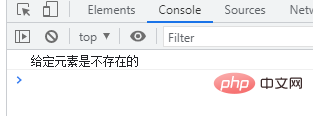How to find whether a specified array element exists in javascript
4 methods: 1. Use includes() to detect, the syntax is "array.includes(element value)"; 2. Use some() to detect, the syntax is "function f(v) {if (v== =value) {return true;}}var b= array.some(f);”; 3. Use indexOf() to detect, the syntax is “array.indexOf(value)”; 4. Use lastIndexOf(), the syntax is “array. lastIndexOf(value)".

The operating environment of this tutorial: windows7 system, javascript version 1.8.5, Dell G3 computer.
Method 1: Using the includes() method of the array
The includes() method is used to determine whether an array contains a specified value. Returns true if it is, false otherwise.
arr.includes(searchElement [, fromIndex])
searchElement Required. The element value to be found.
fromIndex Optional. Start looking for searchElement at this index. If negative, the search starts at the index of array.length fromIndex in ascending order. Default is 0.
Example: Determine whether the fruits array contains the given element "Durian"
var fruits = ['苹果',"香蕉", '榴莲', '橘子', '菠萝蜜',"梨子"];
if(fruits.includes('榴莲')){
console.log("给定元素是存在的");
}else{
console.log("给定元素是不存在的");
}
Method 2: Use the some() method of the array
The some() method can detect whether there are elements that meet the conditions in the array. Thinking about it from another angle, it can also be used to detect whether all elements in the array do not meet the specified conditions. If they do not meet the specified conditions, it will return false. If one or more elements match, it will return true.
array.every(function callbackfn(Value,index,array),thisValue)
| Parameter | Description |
|---|---|
| function(currentValue, index,arr) | must. Function, each element in the array will execute this function Function parameters: Parameter description currentValue must be. The value index of the current element is optional. The index value arr of the current element is optional. The array object to which the current element belongs |
| thisValue | Optional. The object is used as the execution callback, passed to the function, and used as the value of "this". If thisValue is omitted, the value of "this" is "undefined" |
Return value: Boolean value. Returns true if any element in the array satisfies the condition, otherwise returns false.
Example:
function f(value, index, ar) {
if (value === '橘子') {
return true;
}
}
var fruits = ['苹果',"香蕉", '榴莲', '橘子', '菠萝蜜',"梨子"];
var b = fruits.some(f);
if (b) {
console.log("给定元素是存在的");
} else {
console.log("给定元素是不存在的");
}The output result is:

Method 3: Utilization The indexOf() method of array
indexOf() method can return the first occurrence position of a specified element in the array. If the element to be retrieved does not appear, the method returns -1.
array.indexOf(item,start)
| Parameters | Description |
|---|---|
| item | must. The element to find. |
| start | Optional integer parameter. Specifies the position in the array to start searching. Its legal values are 0 to stringObject.length - 1. If this parameter is omitted, the search will start from the first character of the string. |
Implementation idea: Use this method to check the first occurrence position of the specified value in the array. If the position exists, the given element is included. If -1 is returned, the given element is not contained.
The implementation code is given below:
var fruits = ['苹果',"香蕉", '榴莲', '橘子', '菠萝蜜',"梨子"];
var b = fruits.indexOf("桃子");
if (b>0) {
console.log("给定元素是存在的");
} else {
console.log("给定元素是不存在的");
}The output result is:

Method 4: Use the lastIndexOf() method of the array
lastIndexOf() method to search for elements in the array and return the position where it last appeared. If the element to be retrieved does not appear, the method returns -1.
array.lastIndexOf(item,start)
| Parameters | Description |
|---|---|
| item | Required. Specifies the string value to be retrieved. |
| start | Optional integer parameter. Specifies the position in the string to begin searching. Its legal values are 0 to stringObject.length - 1. If this parameter is omitted, the search will start from the last character of the string. |
实现思想:利用该方法检查指定值在数组的最后出现位置,如果位置是存在的,则包含该给定元素;如果返回-1,则不包含该给定元素。
下面给出实现代码::
var fruits = ['苹果',"香蕉", '榴莲', '橘子', '菠萝蜜',"梨子"];
var b = fruits.lastIndexOf("葡萄");
if (b>0) {
console.log("给定元素是存在的");
} else {
console.log("给定元素是不存在的");
}输出结果为:

【相关推荐:javascript视频教程、编程视频】
The above is the detailed content of How to find whether a specified array element exists in javascript. For more information, please follow other related articles on the PHP Chinese website!

Hot AI Tools

Undresser.AI Undress
AI-powered app for creating realistic nude photos

AI Clothes Remover
Online AI tool for removing clothes from photos.

Undress AI Tool
Undress images for free

Clothoff.io
AI clothes remover

Video Face Swap
Swap faces in any video effortlessly with our completely free AI face swap tool!

Hot Article

Hot Tools

Notepad++7.3.1
Easy-to-use and free code editor

SublimeText3 Chinese version
Chinese version, very easy to use

Zend Studio 13.0.1
Powerful PHP integrated development environment

Dreamweaver CS6
Visual web development tools

SublimeText3 Mac version
God-level code editing software (SublimeText3)

Hot Topics
 How to implement an online speech recognition system using WebSocket and JavaScript
Dec 17, 2023 pm 02:54 PM
How to implement an online speech recognition system using WebSocket and JavaScript
Dec 17, 2023 pm 02:54 PM
How to use WebSocket and JavaScript to implement an online speech recognition system Introduction: With the continuous development of technology, speech recognition technology has become an important part of the field of artificial intelligence. The online speech recognition system based on WebSocket and JavaScript has the characteristics of low latency, real-time and cross-platform, and has become a widely used solution. This article will introduce how to use WebSocket and JavaScript to implement an online speech recognition system.
 WebSocket and JavaScript: key technologies for implementing real-time monitoring systems
Dec 17, 2023 pm 05:30 PM
WebSocket and JavaScript: key technologies for implementing real-time monitoring systems
Dec 17, 2023 pm 05:30 PM
WebSocket and JavaScript: Key technologies for realizing real-time monitoring systems Introduction: With the rapid development of Internet technology, real-time monitoring systems have been widely used in various fields. One of the key technologies to achieve real-time monitoring is the combination of WebSocket and JavaScript. This article will introduce the application of WebSocket and JavaScript in real-time monitoring systems, give code examples, and explain their implementation principles in detail. 1. WebSocket technology
 How to use JavaScript and WebSocket to implement a real-time online ordering system
Dec 17, 2023 pm 12:09 PM
How to use JavaScript and WebSocket to implement a real-time online ordering system
Dec 17, 2023 pm 12:09 PM
Introduction to how to use JavaScript and WebSocket to implement a real-time online ordering system: With the popularity of the Internet and the advancement of technology, more and more restaurants have begun to provide online ordering services. In order to implement a real-time online ordering system, we can use JavaScript and WebSocket technology. WebSocket is a full-duplex communication protocol based on the TCP protocol, which can realize real-time two-way communication between the client and the server. In the real-time online ordering system, when the user selects dishes and places an order
 How to implement an online reservation system using WebSocket and JavaScript
Dec 17, 2023 am 09:39 AM
How to implement an online reservation system using WebSocket and JavaScript
Dec 17, 2023 am 09:39 AM
How to use WebSocket and JavaScript to implement an online reservation system. In today's digital era, more and more businesses and services need to provide online reservation functions. It is crucial to implement an efficient and real-time online reservation system. This article will introduce how to use WebSocket and JavaScript to implement an online reservation system, and provide specific code examples. 1. What is WebSocket? WebSocket is a full-duplex method on a single TCP connection.
 JavaScript and WebSocket: Building an efficient real-time weather forecasting system
Dec 17, 2023 pm 05:13 PM
JavaScript and WebSocket: Building an efficient real-time weather forecasting system
Dec 17, 2023 pm 05:13 PM
JavaScript and WebSocket: Building an efficient real-time weather forecast system Introduction: Today, the accuracy of weather forecasts is of great significance to daily life and decision-making. As technology develops, we can provide more accurate and reliable weather forecasts by obtaining weather data in real time. In this article, we will learn how to use JavaScript and WebSocket technology to build an efficient real-time weather forecast system. This article will demonstrate the implementation process through specific code examples. We
 Simple JavaScript Tutorial: How to Get HTTP Status Code
Jan 05, 2024 pm 06:08 PM
Simple JavaScript Tutorial: How to Get HTTP Status Code
Jan 05, 2024 pm 06:08 PM
JavaScript tutorial: How to get HTTP status code, specific code examples are required. Preface: In web development, data interaction with the server is often involved. When communicating with the server, we often need to obtain the returned HTTP status code to determine whether the operation is successful, and perform corresponding processing based on different status codes. This article will teach you how to use JavaScript to obtain HTTP status codes and provide some practical code examples. Using XMLHttpRequest
 How to use insertBefore in javascript
Nov 24, 2023 am 11:56 AM
How to use insertBefore in javascript
Nov 24, 2023 am 11:56 AM
Usage: In JavaScript, the insertBefore() method is used to insert a new node in the DOM tree. This method requires two parameters: the new node to be inserted and the reference node (that is, the node where the new node will be inserted).
 JavaScript and WebSocket: Building an efficient real-time image processing system
Dec 17, 2023 am 08:41 AM
JavaScript and WebSocket: Building an efficient real-time image processing system
Dec 17, 2023 am 08:41 AM
JavaScript is a programming language widely used in web development, while WebSocket is a network protocol used for real-time communication. Combining the powerful functions of the two, we can create an efficient real-time image processing system. This article will introduce how to implement this system using JavaScript and WebSocket, and provide specific code examples. First, we need to clarify the requirements and goals of the real-time image processing system. Suppose we have a camera device that can collect real-time image data






